
Left Panel
The sacred source of everything living on the Earth was compromised by Hieronymus Bosch’s owl, a symbol of darkness, spiritual blindness and heresy. We dare to assume that in such a way the artist visualized a widely-spread dogma dominating that time that any life is sinned.
Some art experts found in this the astrological context. The pink chitinous fountain symbolizes Cancer, an owl is a symbol of a dark Saturn bringing mishap. Saturn in Cancer is considered to be a troublesome sign of the Horoscope, which was associated with the Judgement Day in the times of Bosch.

God holding Eve by her wrist as at the wedding service blesses their union seeming to say: " Be fruitful, and multiply"; the rabbits, symbolizing fecundity at all times, prove this. Though, the works of God react differently rousing theological endless discussions among scholars surveying Bosch’s oeuvre. Adam is looking at Eve with adoration and enthusiasm. Eve is shyly looking down, which is suspicious. If Eve had not tasted the forbidden fruit, She would not have had any idea about such categories like Good and Evil. She would have had no knowledge about shame. So, Bosch denied the concept of gender equality — he considered a woman initially sinned.
In the left panel of the triptych everybody is eating somebody. The lion does not simply rest next to the sheep, it is eating flesh, which is a deliberate mismatch with the biblical history.
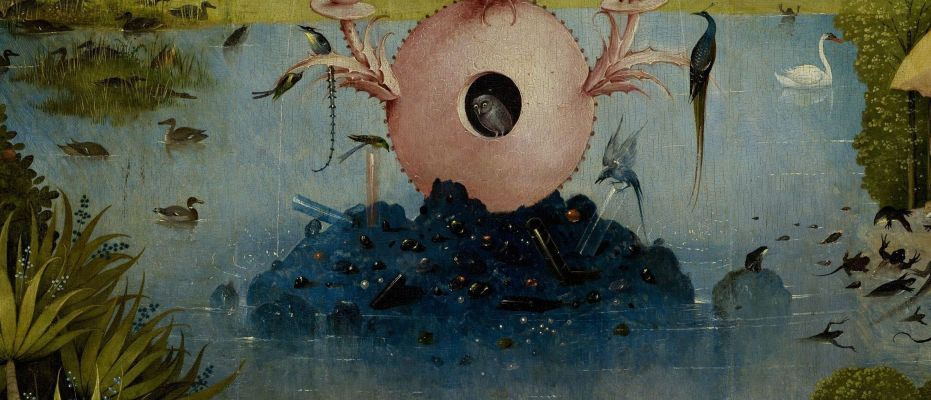
To the left of the source of life the artist depicted ducks which at the times of Bosch were thought to be the lowest as they sunk in mud till their eye. Kingly swan is depicted to the right hand symbolizes purity and hints at the Illustrious Brotherhood of Our Blessed Lady also called 'swan-brethren' because they used to donate a swan for the yearly banquet; Bosch had been its member to his death. We cannot exclude the contradistinction, too. At the same time the swan moves to the same direction as the contemptible amphibians. We also could assume that the ducks and the swan imply the idea of a paradisaical tolerance: the fountain engenders all around, both the Sublime and the Earthly.
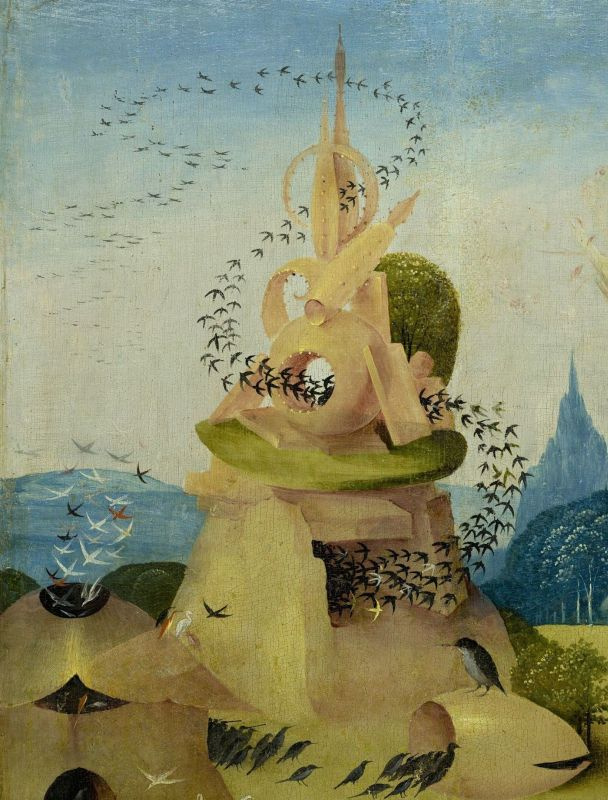
5. Birds
Black birds are associated with sin. The meaning this symbol implies is enhanced by the line of the birds to the empty egg shell symbolizing a false faith or a soul being idle and not knowing the God. Bosch again and again brought the element of darkness into the Paradise. Logically such dualism is not an evidence of Bosch’s belonging to some heretical cult (regardless some biographers insist on). The Evil should exist even in the Eden. Otherwise committing the original sin Adam and Eve would have had nothing to know.
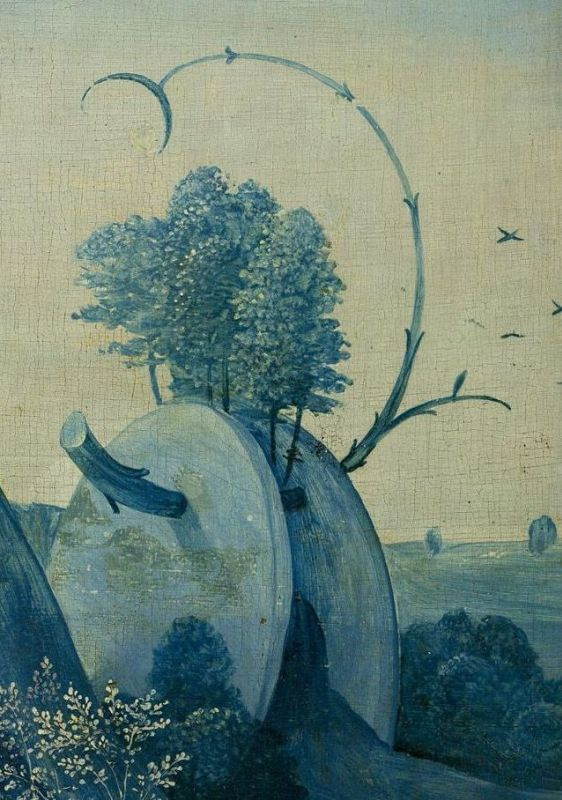
6. Crescent Moon
The construction of two roundish planes tightened with a narrow axis is the image which we can often find in the paintings by Hieronymus Bosch (refer to the ears with the knife in the right panel). No one of responsible art experts has been able to discover what it really implies. Though, the crescent moon crowning the limb, which joins the planes with the crescent moon, is an explicit sign. It is no accident that the Turkish crescent moon is a constantly recurring image in the paintings of Bosch associated with the enemies of the Christianity (refer also to The Ship of Fools).
The Central Part
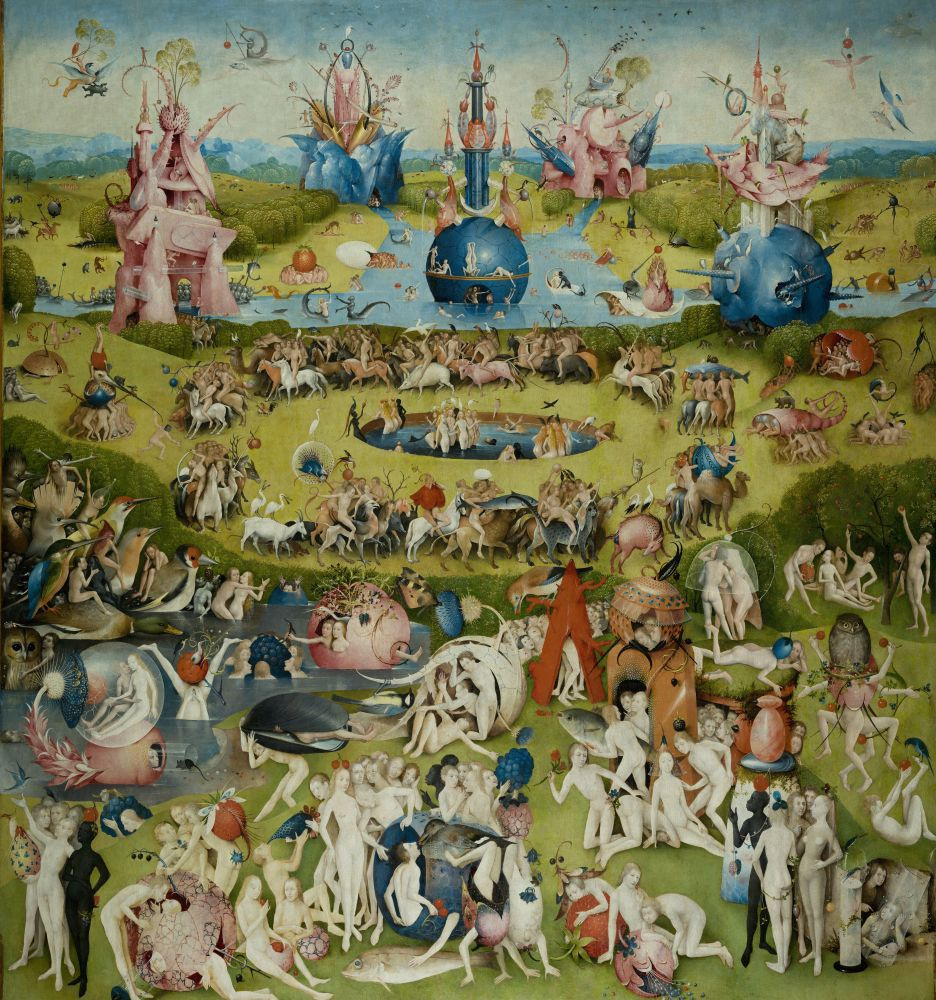

Some art experts assume that Hieronymus Bosch was a member of a heretical sect of the Adamite cult; they wore no clothing during their religious services and advocated free love and rejected marriage, thus, the artist populated his paintings with numerous nude figures in unusual poses. This theory is attractive, though, hardly probable as far as the inquisition of that time ran rampant. Moreover, with the greatest respect to the progressiveness of the Adamites of the Medieval time, it is difficult to believe that they were so open and inventive. Bosch most probably depicting his characters nude focused on revealing sins and vices of humans and unleashed the human nature hidden under sack clothes, robes of priests and powdered wigs.
Depending on the cultural or religious contexts different berries could imply various senses. For instance, blackberries symbolized purity and innocence of the Blessed Virgin Mary, wild strawberries were the symbol of goodness and hard working. At the same time the giant berries in Bosch’s artworks were the allegory of immorality and primarily of promiscuity. Maybe that was the reason why people in the Medieval Netherlands and elsewhere called their vicious fondness by the name of delicious stuff.
Some scholars suggest that in the central part of the Garden of Earthly Delights painting Hieronymus Bosch depicted the Golden Age, when the Earth never knew a plough, was fructiferous and people lived belly-fulled, idle and delighted.
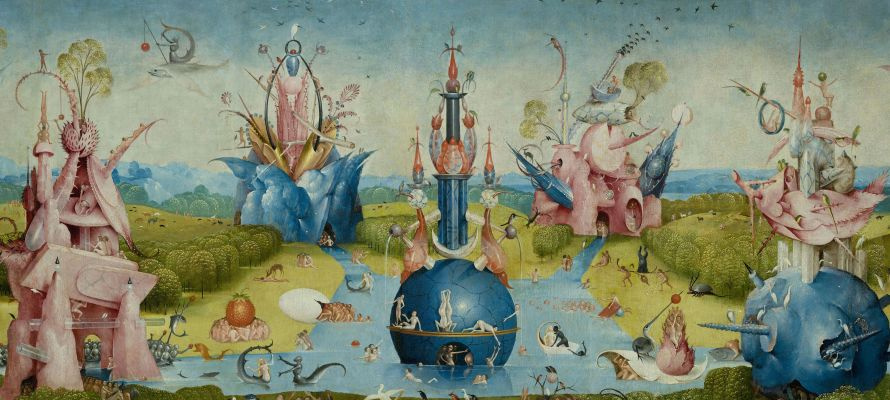
A lot of researchers and art experts agree that the fountain in the central part of the triptych is an esoteric source of eternal youth and whimsical constructions around it are four corners of the earth. The symbols of false faith and sin (for instance, the empty eggshell or the giant berries), which were scattered by Bosch in his painting to highlight his attitude to alchemy as well as to heresy, support this theory.

The cavalcade of riders on goats, calves, lions and other (exotic and not very much) animals is evidently the ironical image of the other pseudoscience and half-heresy, which is astrology. The circle of animals (zodiac in Greek) is moving counterclockwise, i.e., in the unnatural way according to Bosch.
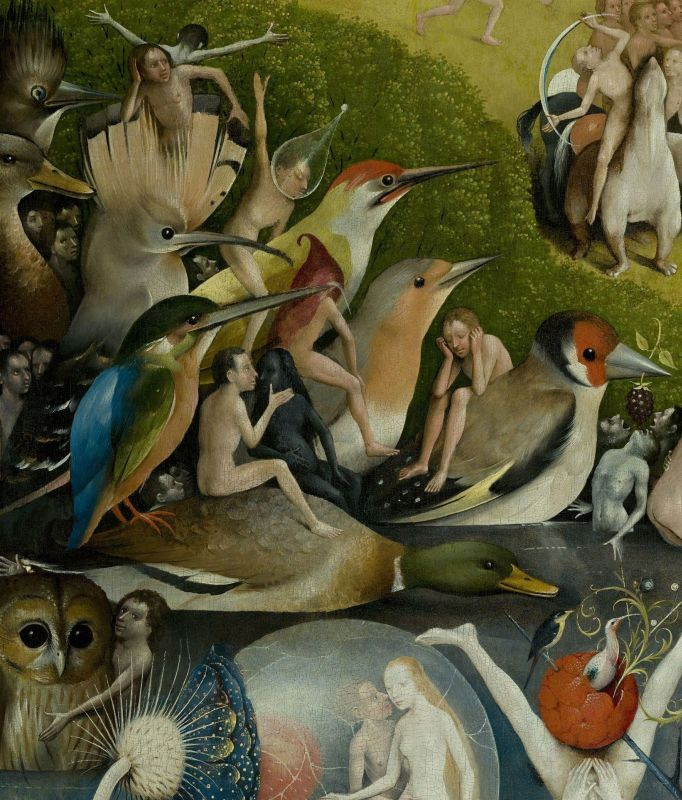
5. Feathered Evil
Birds by Bosch are responsible for human vices again, this time in the context of a species diversity. Here is the "dirty" duck, which we observe in the left panel, and a hoopoe, which as peers of Bosch said is much more sinned than the Devil, because of its gorgeous feathers but excrement for its food. Do not forget about the ubiquitous owl, which is also an evident phallic symbol.

6. Glass Sphere
Glass vessels depicted by Bosch are more likely an alchemy allegory: canoodling lovers like chemical elements are reacting with each other in retorts and cornues. Though, the people, separated themselves with the glass "armor" are likely symbolize such vice like egoism. Moreover, Bosch in his painted messages encrypted the local folklore. Some art experts think that this fragment might be meant to recall the Flemish saying, "Happiness is like glass, it soon breaks."
The dried tree in the form of an upturned funnel is the image with a double accusatory power. A hollow tree is a symbol of death, the hell and unbelief. The upturned funnel is an attribute of a false wisdom and swindle (refer to the Extraction of the Stone of Madness or The Cure of Folly). In this case the devilish log of a red color is not by coincidence, it hints at the robe of the Prince of the Church. The priests hiding under the rotten trunk are blind, deaf and weak. They got stuck in sins like the alchemist and the hoopoe did. The scholars believe that Bosch contraposed them to the group of the good Catholics he placed not far from them (for example, the members of the Illustrious Brotherhood of Our Blessed Lady in’s Hertogenbosch, the native town of the artist). Regardless the glass sphere, a symbol of true belief covering them, they seem to be horror-stricken of what is going on around.
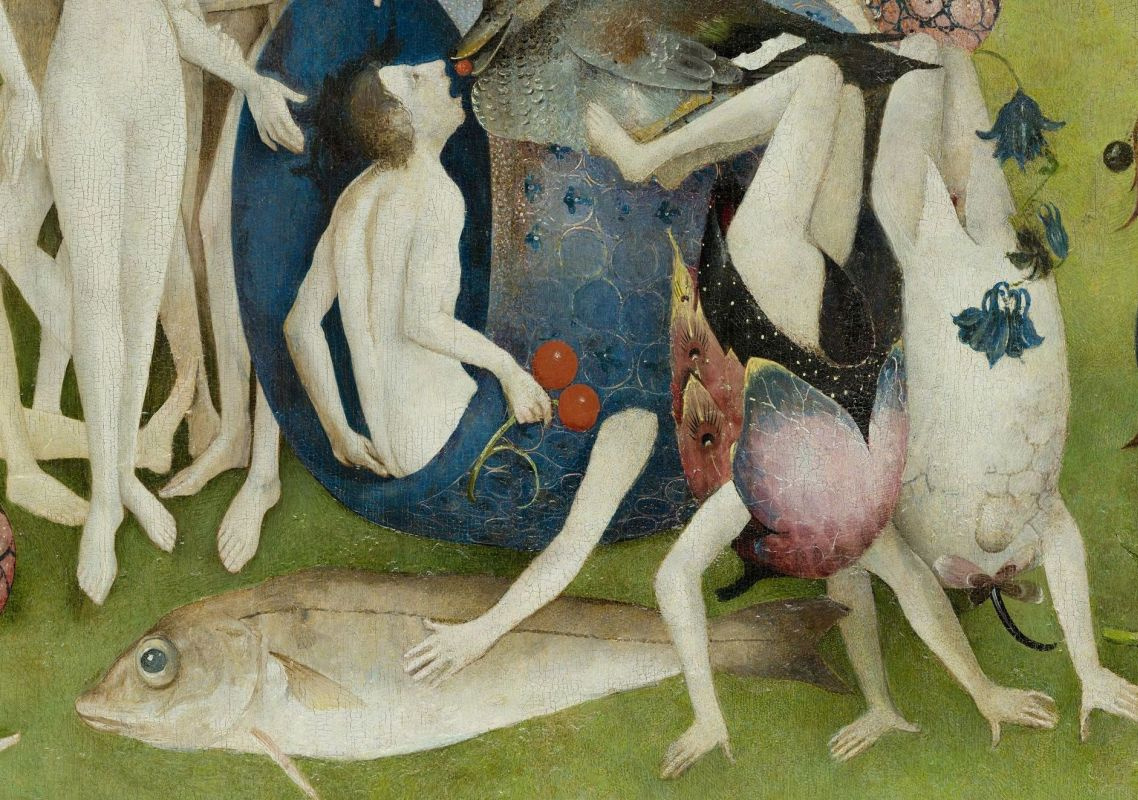
No doubt that fish in the paintings by Bosch so often like his ubiquitous owls has its special important sense. However the symbol is so universal that the sense intended by the artist from a certain fish, whether it is alive or dead, flying or wise, is leaving the world to wonder. In the Medieval time the image of a fish could imply Christ, a zodiac sign, the Moon, water, phlegmatic temperament, an attribute of lust and a symbol of the Lent. Finally, a fish could be just a fish.
Right Panel
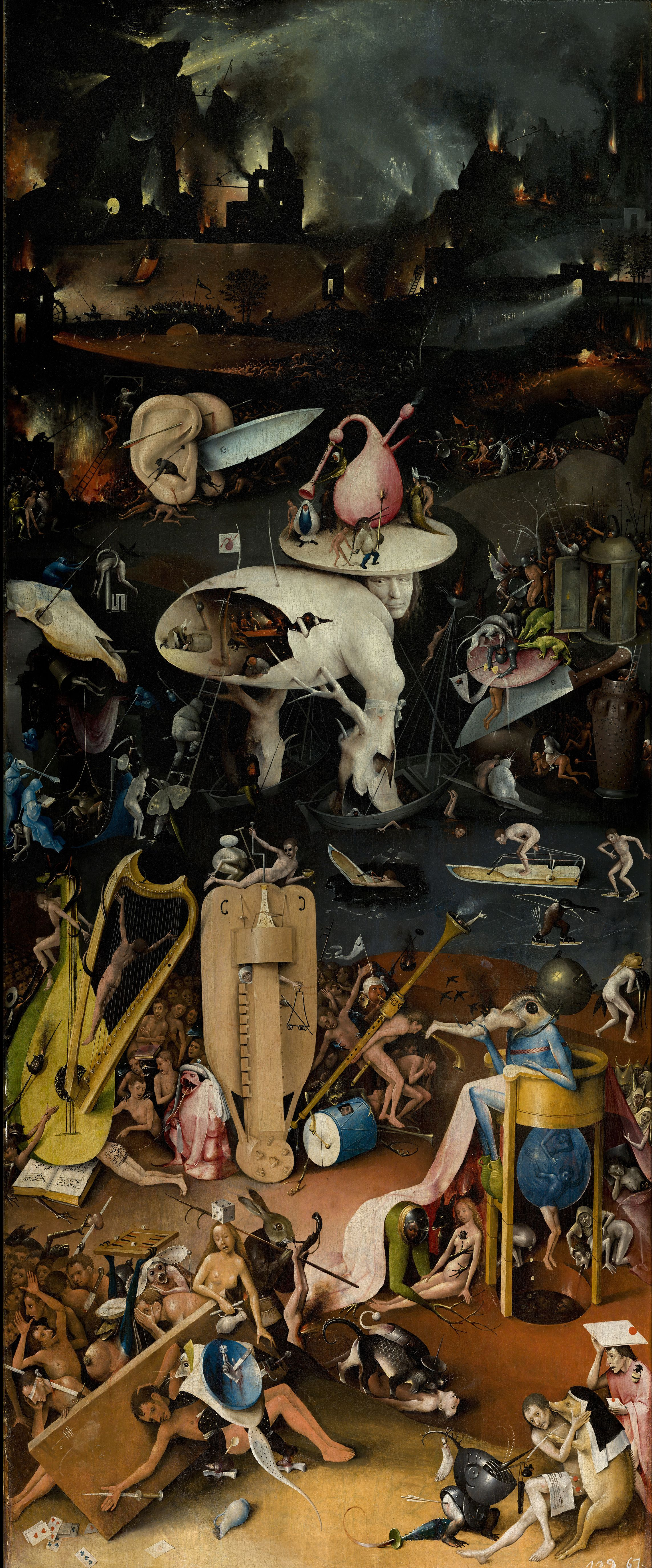
Hieronymus Bosch
the 1500-s, 220×97.5 cm

So-called melancholic monster got its name for the moveless countenance. He does not care that his wooden body is dried and cracked and the company of daring sociopaths is feasting in its belly. A dead tree and hollow egg shell are the symbols of death and sin revealing in this case a particular vice, it is debauchery. The legs of the creature are booted in boats, regardless its heavy constitution, the monster is teetering. By the way, some experts think that it is a self portrait of the artist. The face of the wooden drunker is carefully drawn as though Bosch wanted to make him alike somebody in particular. Though, if we compare the melancholic monster with the survived portraits of Bosch, then the likeness could be very conventional. We have no evidences whether Bosch was a drunker or he joined a temperance league in’s Hertogenbosch. So it is very difficult for us to conclude whether it is a self portrait or not.
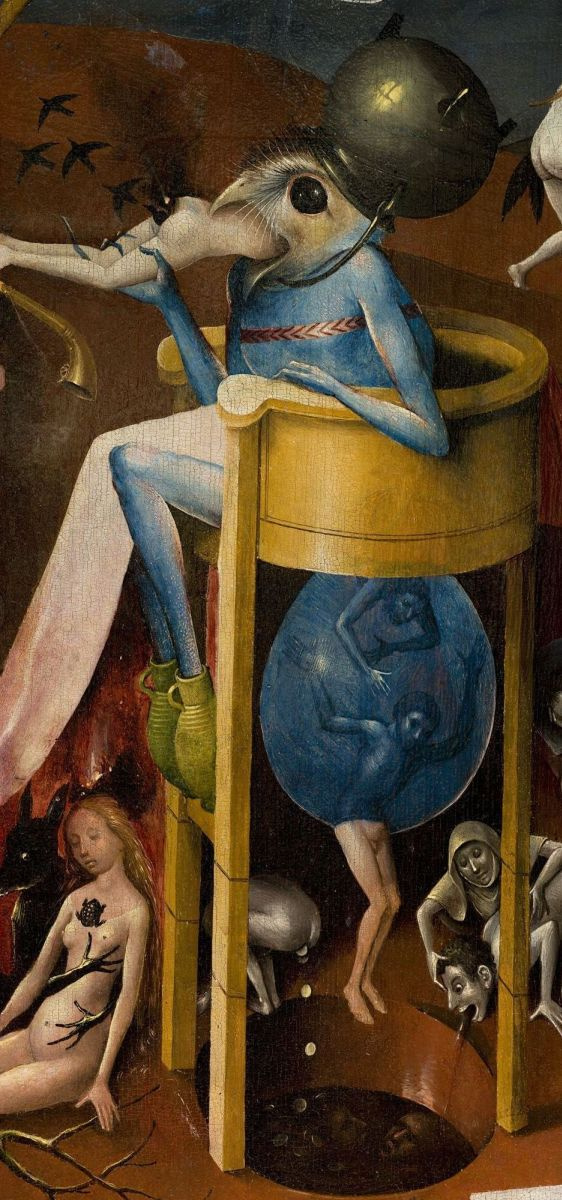
2. Monster with Bird Head
The monster with a bird head is reputedly the Prince of Hell devouring souls of sinners. Sitting on an object that may be a toilet or a throne, which he excretes through a cavity below him, into the transparent chamber pot on which he sits. He wears the cauldron on his head, perhaps representing a debased crown, symbolizing (like any empty pot) unbelief. The jars on his legs emphasize his limp after his downfall from the Heavens.
At the same time there is a theory claiming the beaked monster a symbolizes a ruthless time. Saturn or Cronus usually was described in the books on astrology as lame or one-legged with a zodiac sign of Aquarius as a jar instead of another leg. Some experts assume that jars on the Cronus’s legs are cothurni, which wore the actors performing in ancient Greek tragedies.
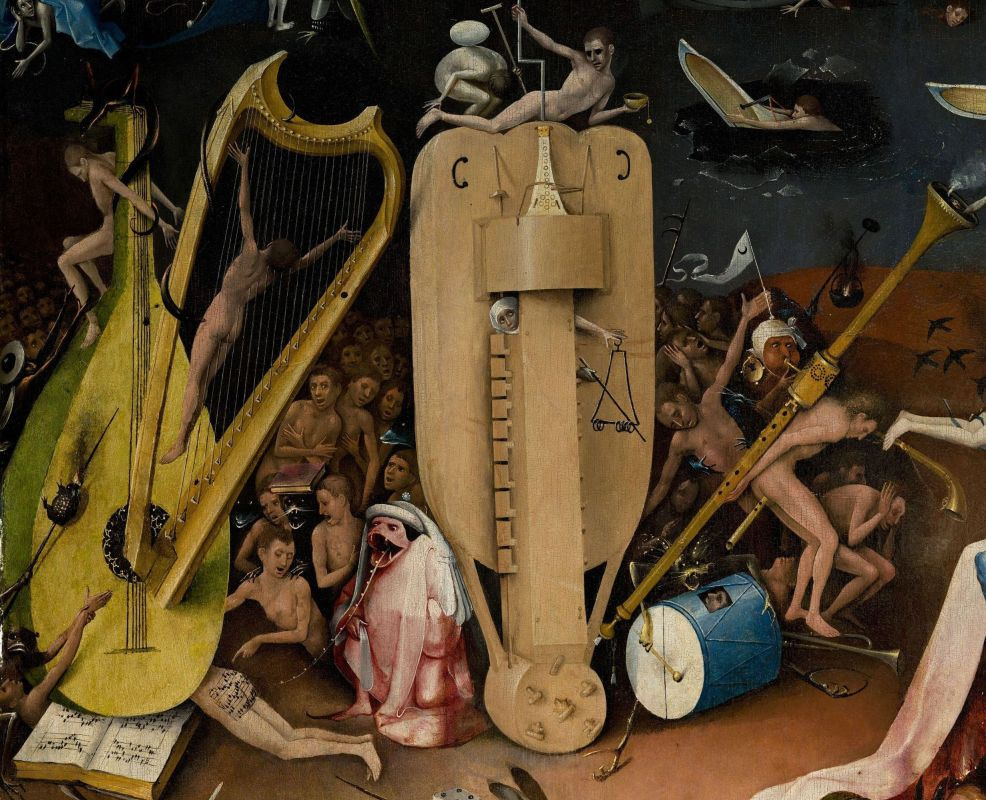
In the times of Bosch the saying "lust is a music of flesh" was very popular in the Netherlands. The music of that time served for enjoyment before love making. The polyphonic music was considered to be sinned and its performance in the church was a devious form of heresy. Bosch likely shared that attitude of the Catholic Church for he depicted musical instruments as instruments of torture; some avant garde musicians do the same nowadays.
The figure of a nude girl with a 6-sided die on her head, a cut off hand with a die on its finger, the upturned card table, a pregnant devil probably proposing to play backgammon. the meaning of this fragment is obvious: the sinners obsessed with the sin of games of fortune and chance would have to roll the dice at the Day of the Last Judgement. By the way, scrutinizing the fragment you could find a trey and ace among the cards betossed on the ground. Hieronymus apparently hid a valle card in his sleeve.
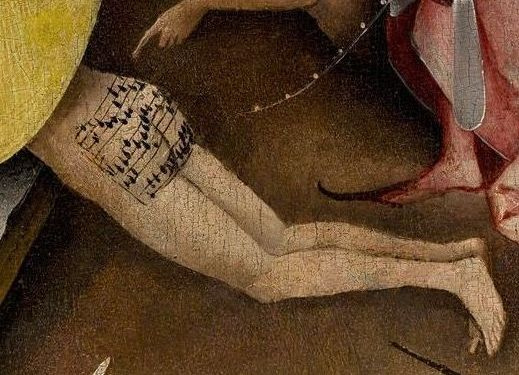
The central theme of the oeuvre of Bosch is a buttock. The reason was that a butt was perhaps the main character of the Medieval Flemish folklore. The experienced adults told young men for their education that a man stored a whip for his own butt. They said to young temptresses that if they looked in the glass for a long time they could see the devil’s ass. Depiction of a buttock struck with an arrow symbolized a visitation for sins. In a word it is a transcultural symbol having lost nothing in its meaning for the last 500 years. Like in the times of Bosch, nowadays our asses are still in trouble.
The ladders abounding the triptych The Garden of Earthly Delights symbolize the path to knowledge and the knowledge, as we are aware of, is the way to the Fall from grace. So, we can say that Bosch’s ladders imply the same meanings as his birds, dried trunks or empty pots, all of them are the symbols of vices.


Associations connected with knives do not require complex explanations: they imply martyrdom, tortures, penalty for our sins. Much more interesting the letter M marked the knives in the Garden of Earthly Delights. Some scholars think that it could be the first letter in the word "mundus" (peace) or it could be the name of the Beast: according to the Medieval foreknowledge his name would start with M.
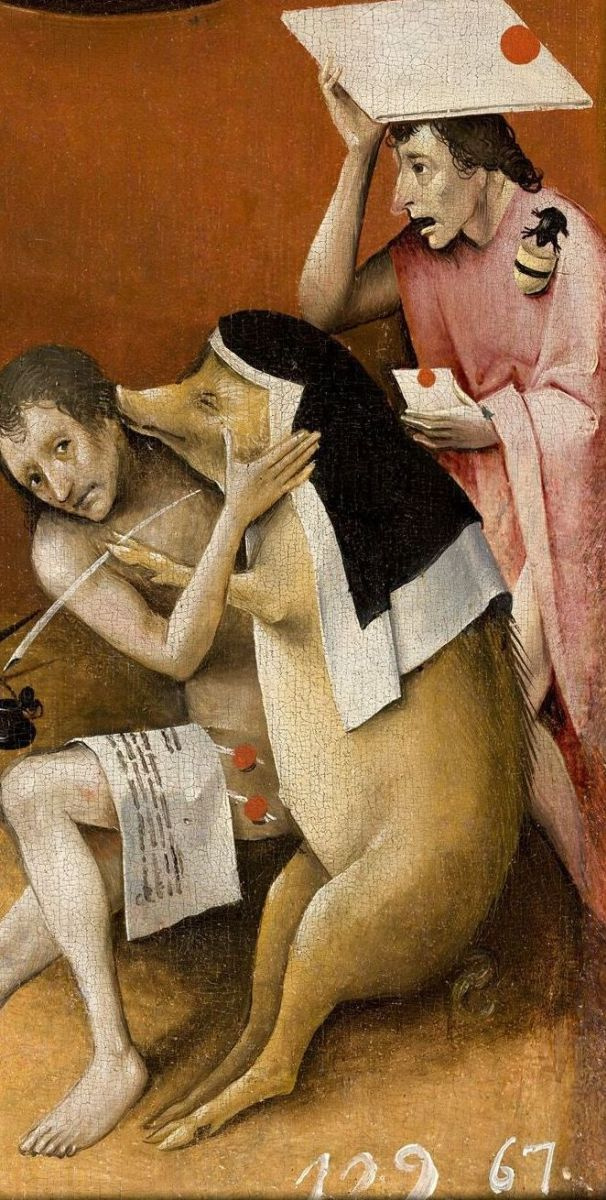
8. Pigs
The sinner hugging the pig in a nun’s habit can be another satirical hit on the Catholic Church whose greed Hieronymus Bosch tirelessly criticized in his artworks. A document sealed with a stamp is on the knees of the sinner, the other figure (with a frog on his shoulder symbolizing heresy) covers his head with a stamp. We dare to assume that this could be an indulgence the trading of which Bosch with reason considered cheating.
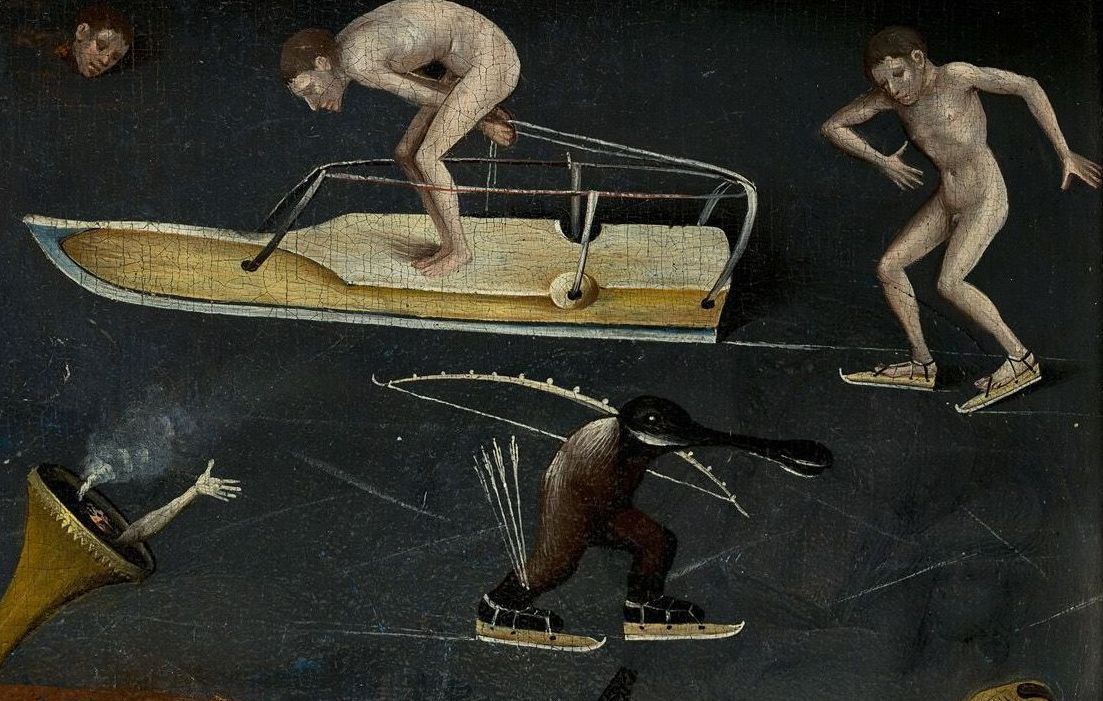
Numerous figures wearing ice skates in the paintings of Bosch were perhaps of the infernal origin: according to the Medieval concept the lowest circle of the hell was the lake covered with ice. It might be that the artist associated ice skates with idleness. For instance, one of the ice skater depicted in his Temptation of St Anthony triptych is holding in his beak a paper with a word "laziness".
The author: Andrey Zimogliadov







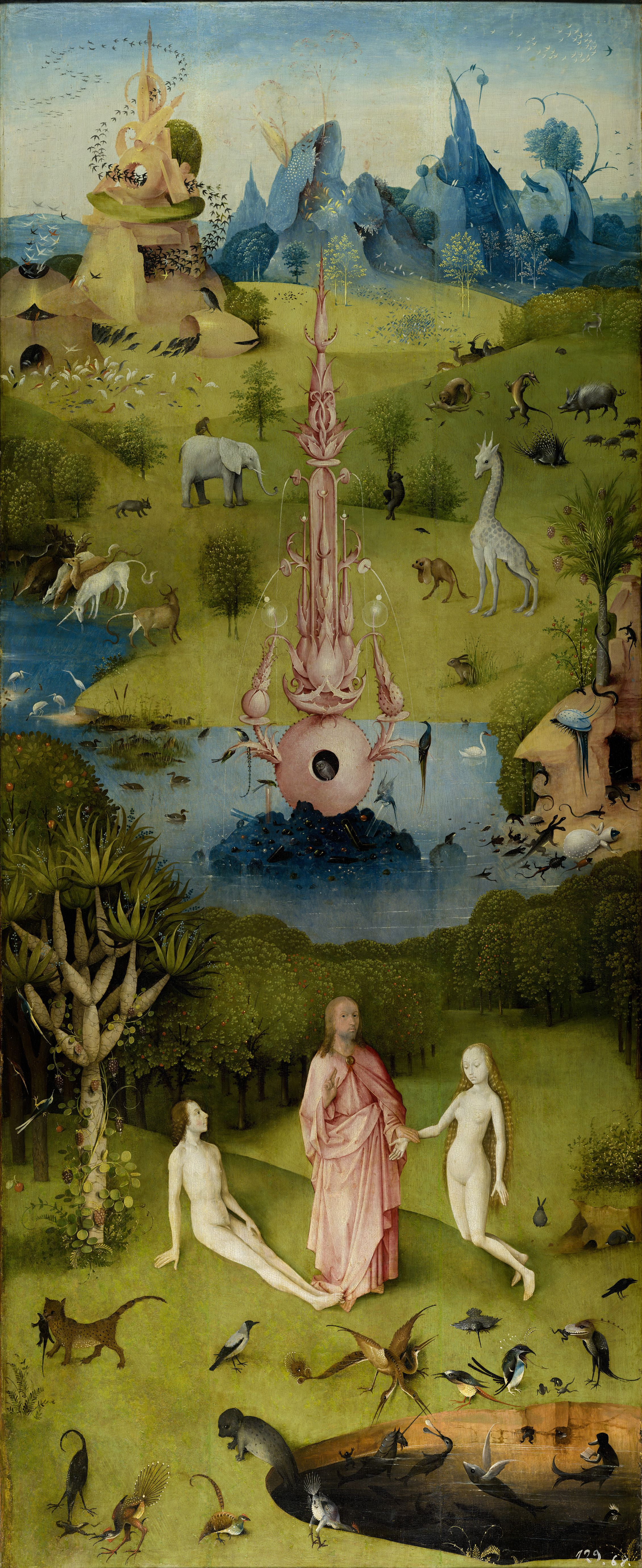

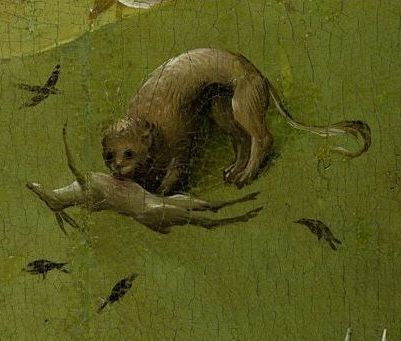
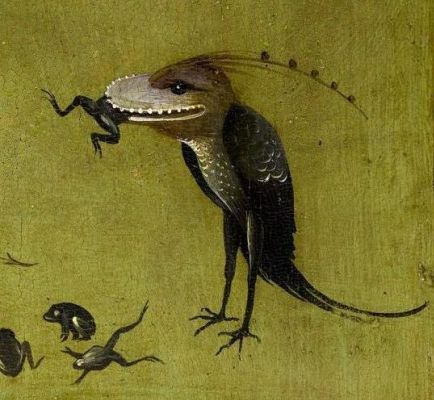
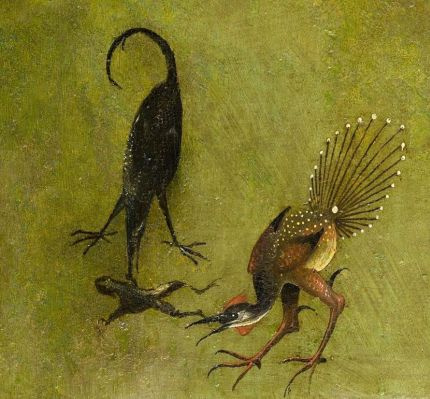
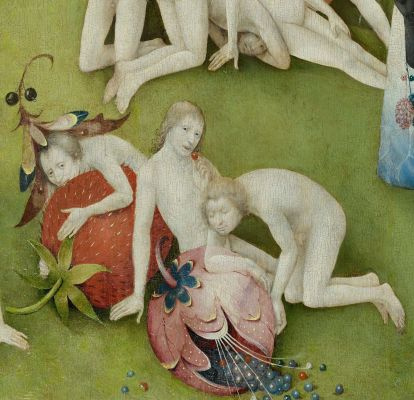
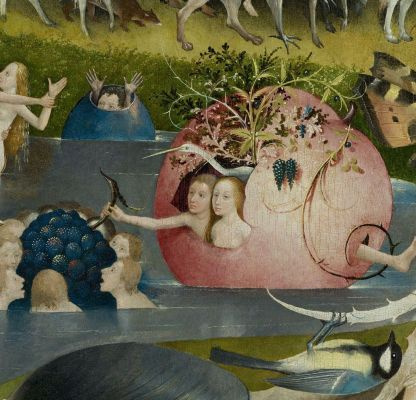
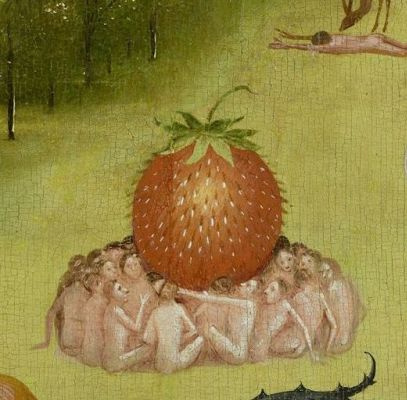
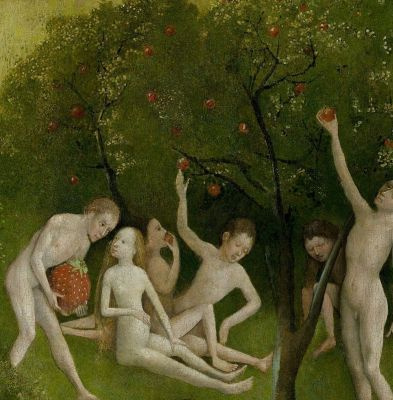

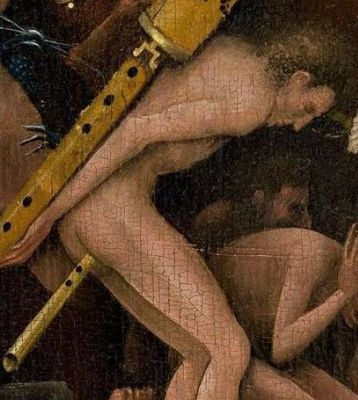
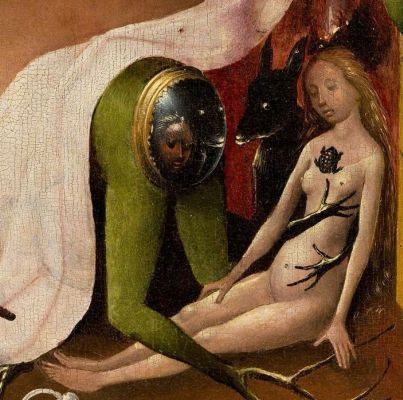


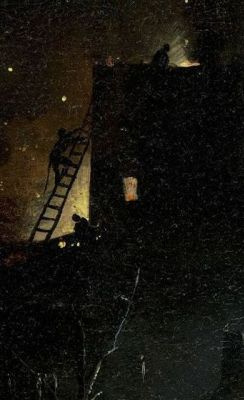

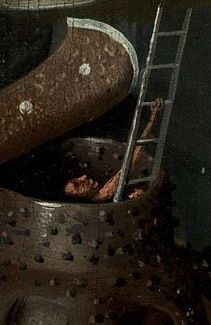






Hieronymus bosch
Garden of Earthly Delights
This huge triptych *
It’s hard to immediately understand
So from these to these
Verbally convey -
And Paradise and Hell and the world of people
Placed in this picture!
On the left wing, Adam and Eve
Near the forbidden tree to them.
Almighty introduced them
Leaving then alone.
Garden of pleasure in the central part
With his sins of voluptuousness.
What figures and poses are not here -
Here, for example, is one plot:
(a fragment of the Garden is shown here)
On the right wing - the end of the path
With his payback for happiness ...
Here is Hell. He can't get around -
Reminds people of the Master ...
*) 390 * 220 cm.